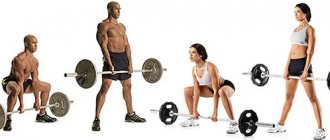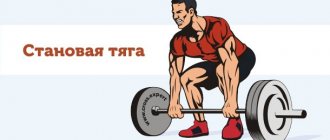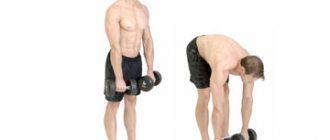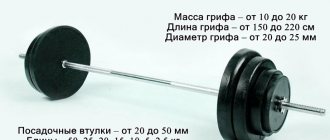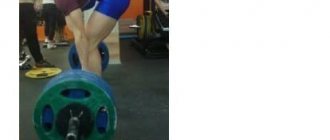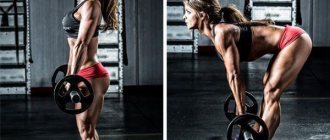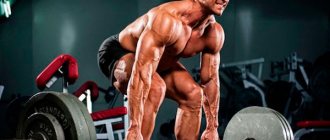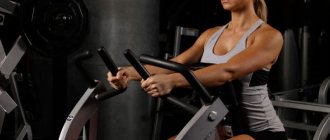Share:
What you need
- Barbell
- Platform
Sumo Deadlift is a basic strength exercise that involves lifting a barbell from the floor with legs wide apart to waist level. The sumo deadlift has become widespread in powerlifting, crossfit and other strength sports, as it allows you to fully unleash the athlete’s strength potential and achieve impressive strength records. Today we will tell you about the correct technique for performing a sumo deadlift, how this type of deadlift differs from others, and how to progress in it.
In our article today we will look at:
- What are the ways to perform deadlifts?
- Technique for performing the exercise;
- Newbie mistakes;
- How to increase strength in the sumo deadlift;
- CrossFit complexes containing this exercise.
Varieties of deadlift
There are 3 main ways to perform deadlifts: classic, Romanian and sumo. The differences between these movements lie in the different starting positions of the athlete and the different muscle groups working. Romanian deadlift, sumo or classic: which is better? We hope that our article today will help you find answers to these and other questions that interest you.
Classic deadlift
In the classic version of the deadlift, the athlete’s legs are positioned shoulder-width apart, the feet look parallel to each other, the gaze is directed forward, and the movement itself is carried out by the force of the back and hip muscles. The main load is taken on by the spinal extensors; it is through their work that most of the amplitude is passed, while with our legs we only “tear” the bar off the floor and set powerful inertia.
Romanian deadlift
The fundamental difference between the Romanian deadlift and the classical deadlift is the deadlift process itself. It involves minimal leg work and distribution of the main load on the back muscles. The exercises are performed with straight legs throughout its entire amplitude.
Sumo deadlift
When doing sumo-style deadlifts, the legs are positioned wider than the shoulders (in some cases they practically rest against the plates), we hold the bar slightly narrower than shoulder width and lift using the force of the quadriceps, adductor muscles and buttocks. The back movement here is much shorter than in the classic version.
The amplitude of the sumo deadlift is somewhat smaller than that of the classic deadlift, so powerlifters, whose goal is to lift the greatest weight, resort to sumo more often. But CrossFit athletes also do not disdain this exercise, although weight is a secondary factor for them. Some people's anatomy is simply better suited to sumo, other people's anatomy is better suited to classics, which can only be determined through trial and error.
The sumo deadlift requires a good stretch in the hip adductors, this will help you feel more comfortable lifting heavier weights and also minimize the risk of injury.
For many athletes, the question arises: which deadlift is better, sumo or classic? The answer is simple - to each his own, it all depends on your physical and genetic data. If you have long legs and short arms, then it would be more rational to perform a sumo deadlift, if on the contrary, then a classic one.
If your back muscles are more developed, do classic deadlifts, but if your leg muscles dominate in their development, do sumo. Try both options and choose which one is easier for you to maintain the correct technique. Although, on the other hand, why do you need to stop? For comprehensive development, a CrossFit athlete needs to perform both versions of the deadlift, because only an integrated approach and proper distribution of the load lies the path to high athletic achievements and truly impressive performance.
© Makatserchyk — stock.adobe.com
Before you start practicing
Before you start practicing this particular deadlift, you need to thoroughly study the technique of doing it. Deadlifts on straight legs do not tolerate inaccuracies in execution and frivolity in terms of selecting weights.
Therefore, before starting training, you need to sufficiently master the classic deadlift technique and achieve certain results in it.
Whatever the traction, it always requires special attention to fixing the back in a straight position. And it is this exercise that requires special attention and approach, since the angle between the torso and legs (that is, the ratio) is too large.
It should be remembered that the deadlift on straight legs is based, first of all, on good stretching. If there is none, then such activities will be premature and even dangerous to your own health.
If an athlete, for example, is unable to touch the floor with his palms while standing on straight legs, then this will be the first point of a kind of unsuccessful stretching test. Without stretched Achilles tendons, nothing good will come of this venture.
To prevent this from happening, you need to prepare yourself properly by stretching for at least several weeks.
advertising is not displayed
When training to improve stretching, you should not do deadlifts at the same time! And if you do do it, then only with minimal weights and only from an elevation.
The anatomical features of a particular athlete are also very important. In some cases, even with an ideal stretch, it is impossible to perform a deadlift without allowing the back to arch. Such cases require measures to reduce the amplitude of movements, that is, the initial height of the bar must be increased by any available means and methods.
The amplitude should be such that the back always remains straight, regardless of the phase of the movement.
Proper Sumo Deadlift Technique
In exercises such as sumo deadlifts, squats and bench presses, 90% of the result depends on the correct technique. No matter how impressive your data may be, over time you will hit a certain genetic ceiling, which will be extremely difficult to break through if your technique is not honed to perfection. Only by installing filigree equipment will you be able to fully unlock your strength potential, avoiding injuries along the way, thereby maintaining your health. Let's figure out how to do sumo deadlifts correctly.
Preparation
Place the bar as close to your shins as possible, and use gaiters to avoid unpleasant scratches and abrasions. Place your feet wider than shoulder-width apart in a comfortable position; you should maintain a stable position throughout the entire approach. If you feel that your inner thighs don't have enough stretch, start with a narrower stance and gradually increase the width as your muscle fascia becomes more stretched and elastic.
Podsed
Our task is to get hooked on the bar. By sitting down, and not bending over, as many people think, we will immediately fix our back in the correct position. So, when you have chosen the optimal position for yourself in terms of the width of your legs, smoothly begin to squat down. You should feel a slight stretch in the hip adductors. At the lowest point, the knee should be bent at approximately 90 degrees, the toes should be placed slightly to the side, the pelvis should be pulled back, and the gaze should be directed straight ahead.
I recommend warming up and stretching your thigh muscles from all angles before performing sets of sumo deadlifts. Stretching for the sumo deadlift is an essential attribute that will increase the productivity of this exercise.
Spend 5-10 minutes doing static and dynamic stretching (longitudinal and transverse splits, butterfly will come in handy) and you will feel how much easier it will be for you to lift the barbell off the floor.
This video shows some good stretching exercises before performing sumo deadlifts:
Lifting the bar off the floor
Now you need to lift the bar off the floor. To do this, we begin a powerful movement with our legs, we begin to straighten our knees. As soon as the bar lifts off the floor a few centimeters, we move our pelvis forward, this way we will ensure powerful acceleration of the projectile by engaging almost all the muscles of the lower body. The hip adductors, quadriceps and spinal extensors are most actively involved in the work. The buttocks, hamstrings and trapezius muscles are in constant static tension and are responsible for our stabilization. In addition, the biceps and forearms are heavily loaded, since we need to statically hold a lot of weight. The latissimus dorsi, abdominal and neck muscles also receive enough stress to break down the muscle fibers. That is why this exercise is called basic - almost all the large muscles of our body are involved here.
When the bar is located at the level of the middle of the thigh, we bring the buttocks forward as much as possible and at the same time fully extend the lower back. This will put you in the right position, after which you can lower the barbell to the floor. You should not bring the lordosis in the lower back to an unnatural angle, as many athletes do - the compression on the intervertebral discs is simply crazy.
Newbie mistakes
Below are the most common mistakes of inexperienced athletes that you can observe in the gym. If you recognize yourself in any of these areas, seek the help of a qualified personal trainer to correct your technique and prevent possible injury.
- Use the correct deadlift shoes. Barbells are a great thing, but they are more suitable for squats, snatches and clean and jerks; for deadlifts you need shoes with the thinnest possible soles - this way you will shorten the amplitude, and breaking the barbell will be easier. The ideal option is wrestling shoes; they have a thin but rigid sole.
- The bar is too far from the shin. This will make it much more difficult for you to control the position of the body, since the bar will change.
- Using wrist straps and an athletic belt , starting with light weights. Yes, using this equipment makes the task somewhat easier, but it is advisable to learn the correct technique without using it.
- Do not place your feet too wide if you do not have enough stretch for this - this way you risk developing a sprained adductor muscle.
- The back should remain straight throughout the entire exercise. Rounding of the lower back or hunching is unacceptable.
- Respect long-standing traditions - do not step over the bar . Many people think this superstition is stupid, but by not stepping over the bar you will earn credibility with the “old-timers” of the gym. The tradition dates back to the Soviet school of weightlifting, but is still relevant today.
How to increase strength in the sumo deadlift
How to increase your sumo deadlift is not an easy question. I associate the answer to this question with basic knowledge from a school physics course, namely with Newton’s second law, according to which:
F=ma , where
- F – force;
- m – mass;
- a – acceleration.
Conclusion: to lift more weight, you need to give the bar the necessary acceleration from the very beginning of the movement.
Exercises that develop explosive leg muscle strength are great for this , such as squats with a pause at the bottom, standing up from squats, bench squats with a pause, long jumps and box jumps.
We've sorted out the legs - it's with them that we perform a stall and set the inertia for powerful traction. But let's not forget about the back muscles, which are also involved in the work. The function of the back in the sumo deadlift is to fully extend the body, the main force falls on the spinal extensors and trapezius muscles. Therefore, it is necessary to further strengthen these muscle groups, and it is advisable to perform the load both in power and pump style. Perform weighted hyperextensions, barbell or dumbbell shrugs, barbell crunches, and reverse hyperextensions. This will allow you to keep the working back muscles in good tone.
Deadlift in shortened and increased amplitude
Most athletes also separately train sumo deadlifts with a shortened and increased amplitude. Rows in a shortened amplitude are carried out using plinths or other elevation, the bar of the bar is located just below the line of the athlete’s knee. The movement turns out to be shorter, this allows an athlete with a larger weight than when working at full amplitude, additionally loading the back muscles and strengthening grip strength. Typically, athletes work in block deadlifts with a weight that is 20-30% more than the one-time maximum; this helps psychologically to get used to heavy weights.
Pull from the pit
The pit row is a variant of the deadlift in which the barbell is placed on the floor and the athlete stands on a hill (usually no more than 10 cm in height). The movement turns out to be longer, the leg muscles are more involved in the work, which allows you to separately train a powerful and quick fall of the barbell from the floor. Here everything is exactly the opposite - we work with weights 20-30% less than the one-time maximum.
When performing auxiliary work, do not forget about the abdominal muscles, since it is the abs that are responsible for stabilizing the body when performing sumo deadlifts. One workout a week is enough to keep him in good shape, and strong abdominal muscles will not only increase strength results, but will also reduce intra-abdominal pressure, which significantly reduces the risk of umbilical hernias.
Recipes for healthy eating
Italian-style pasta with vegetables
- 11.9 g Protein
- 1.9 g Fat
- 63.1 g Carbohydrates
- 320 kcal
15-25 min.
- #second course
- #olives
- #dinner
- #vegetables
- #paste
- #tomato
- #arugula
- #butter
- #dinner
- #garlic
Other recipes
Sample training program
Most weight lifting exercises are included in the training process either for the purpose of gaining additional volume or to increase strength indicators. Beginners should not immediately lift heavy weights. You should start small. Even experienced lifters are also not recommended to lift the usual weight, since changing emphasis requires adaptation.
If your goal is strength, do 3 sets of 4 reps. This is due to the fact that sumo is not the only pulling exercise, so there is no particular point in striving to give it your all. If the deadlift is done last during training, then you can perform four approaches, but for the final one, take lighter weights and bring it up to twelve repetitions. This loads the muscles to capacity and allows you to completely burn all the remaining energy during the workout.
Those who want to increase muscle size, but not increase strength, should do from eight to twelve repetitions. When the maximum number of repetitions is given without any difficulty, then the weight lifted should be increased. In this case, the number of repetitions is reduced to nine to ten. You need to do three approaches. The sumo deadlift brings maximum benefit only when, after the last repetition, you no longer have the strength to lift the apparatus again. Otherwise, either the weights are too light or the number of repetitions needs to be increased.
